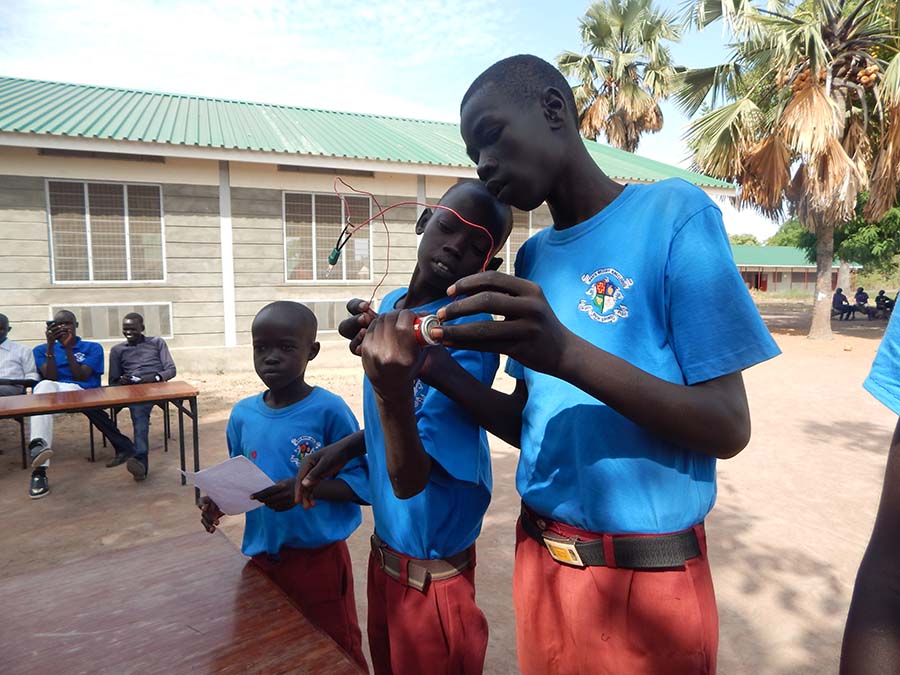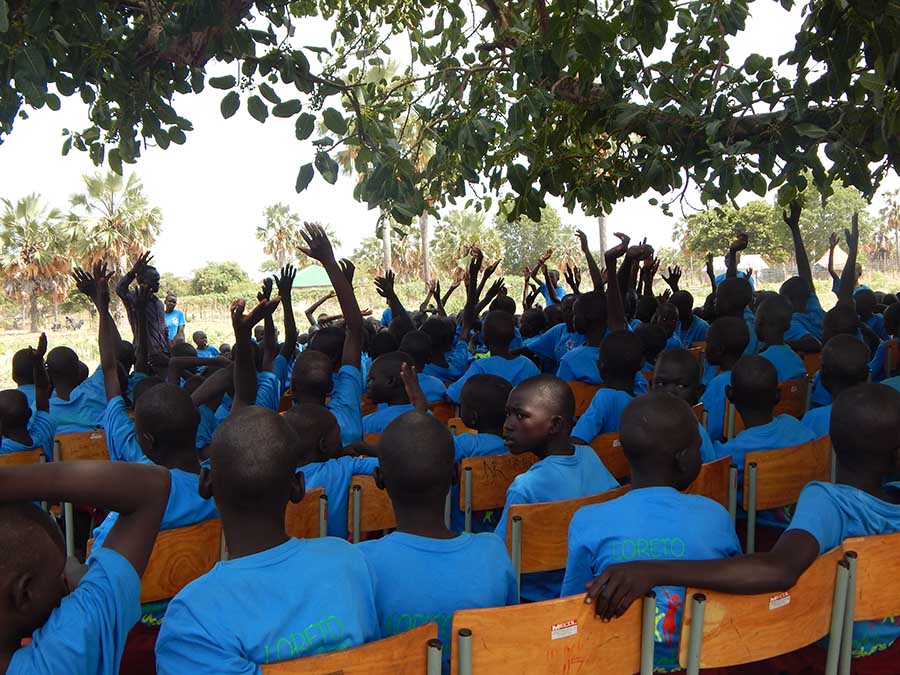News from Rumbek
Sparking an interest in science – the Loreto Science Fair
It is a hot busy day at Loreto Primary School, with an occasional breeze and the sounds of children bursting with excitement as they assemble under a big lulu tree. In a few minutes, the Science Fair will begin, a highly anticipated event filled with educational entertainment. At the end of every term, the school hosts the Loreto Science Fair, where students in upper primary (Primary 5 – 8) present science and technology projects to their peers, teachers and parents.
Gabriel Nyany coordinates the science fairs, and with the help of other teachers, he prepares students for their presentations. He explains, “There is a saying: I hear and I forget, I see and I remember, I do and I understand. When you teach (the students), they do hear it, sometimes they forget, but when you do a practical with them, they understand.”
Isaak Long, a teacher in the primary school echoes these sentiments and sees the long-term impact, “Science is an important way of learning. It helps us know life skills. Exposing the children to such helps them advance their learning too. Slowly by slowly it helps the children develop their abilities and interest in science. Not every child would love science but I find most of our students interested in it and as a teacher I keep encouraging them and show them its importance in modern technology.”
The science fairs are part of a larger project funded by the McCarthey Dressman Educational Foundation with provides afterschool programs for upper primary school students. Everyday, these students stay behind for an hour after lunch to explore science, technology, engineering and mathematics (STEM) topics.
Students engage in experiments and demonstrations to understand scientific concepts such as electricity, magnetism, water filtration, wind energy, sound, light, solar energy and chemical reactions.

Most homes in Maker Kuei are not wired for electricity, and many students are riveted when they learn about and see the construction of a simple circuit. Martha Piath, a Primary 6 student attending the science fair describes her fascination, “I kept thinking of what science can do. I have learned a lot. A connection of batteries can produce electricity, and in another presentation, I learned how the same electricity can be used to operate the fan.”
Students also learn about technology through tablet apps and toys that teach the foundational principles of coding.
During the science fair, the audience erupts into squeals of joy as students present the robot mouse coding project. Simon Mamat, a boy in Primary 5 can barely contain his excitement, “I liked this presentation a lot because I like science. It is my best subject. I would like to learn more of this and teach others later.”
The robot mouse is a crowd favourite, a delight to the young Primary 4 students and their older Primary 7 peers. One of the Primary 7 presenters, Abraham Laat describes the appeal of this project,
“I like the robot mouse idea. It shows how technology works. I am the one who was operating and coding the mouse (during the presentation). Through technology, the mouse was able to uncode the message and navigate from one point to the other. I like science. One can learn a lot. Using this idea one can make real things like cars. To me I think it is the same technology used on computers. Being able to operate the robot mouse makes me feel good. I would feel good to get more things like this to learn from.”
Students also engage in engineering challenges using materials such as Engino (lego-like) blocks in the afterschool program. Primary 8 students Mandela Mangar and Christine Atueny were among the first students to participate when the afterschool STEM program started in 2015. According to Mandela,
“It helped us learn how to make all those things, like how to build chair swings and wells with the (Engin) blocks.” Christine adds, “I enjoyed building the houses.” Both students have previously presented at the science fairs and believe that it has helped them to build confidence and to give presentations/talks in English.
Most children in the area struggle with speaking English and girls usually lack confidence when speaking in public. Moreover, the help that they receive from their teachers during preparation for the presentations helps them to better understand the concepts.

Mandela explains further, “It can help us, like when we don’t know how to present something, we have a chance to learn and then show everyone else.” Jamesina Cholhok, a Primary 6 English teacher, agrees with Mandela, “They (the presenters) were so confident! The ones that were explaining were talking loudly and confidently.” She added, “Most of the girls know how to present, I think they will be more confident as they continue.”
Jamesina also works with Primary 6 students in the afterschool program and she has seen its impact on her students’ academic performance, especially girls. An important aspect of the STEM program is the provision of tablets with apps for remedial mathematics. These apps encourage self-directed learning, allowing students to learn at their own pace.
The afterschool program also has a higher teacher to student ratio than the day school, which provides students with more individualized attention. Students can choose to work on topics that they struggle with, along with the support of a teacher, if needed. Or, they can decide to further explore topics that they perform well in, which builds their interest in and enjoyment of mathematics. This is especially beneficial to girls who struggle with low expectations for their performance in mathematics due to negative societal stereotypes. Jamesina describes the effect of the program on her students,
“It helps the girls so much because they start early – in Primary 5, with the maths on the tablets. Most of them are passing maths now. One girl got 80% in maths and I asked her how. She told me that she got the interest when they got introduced to maths on the tablets. She is (usually) the first to come for the tablet (in the afterschool program). They enjoy it!”
As the science fair ends, students stream back to their classrooms, carrying their chairs and big smiles. The Primary 4 students are especially happy, thinking about next year when they will begin Primary 5 and participate in the afterschool program. As they leave, the students are brimming with ideas. Monica Amakou, a student in Primary 6 describes her thoughts,
“Connecting batteries to produce light, using magnets and the idea of like poles repel and unlike poles attract helps separate mixtures of metal pieces. Science is like everything. A lot of things are based on science. If I got the materials I can connect and make light for myself even at home.”
Sign up to our newsletter
Keep up to date with news, fundraising events and activities
Want to help us further? Make a Donation
